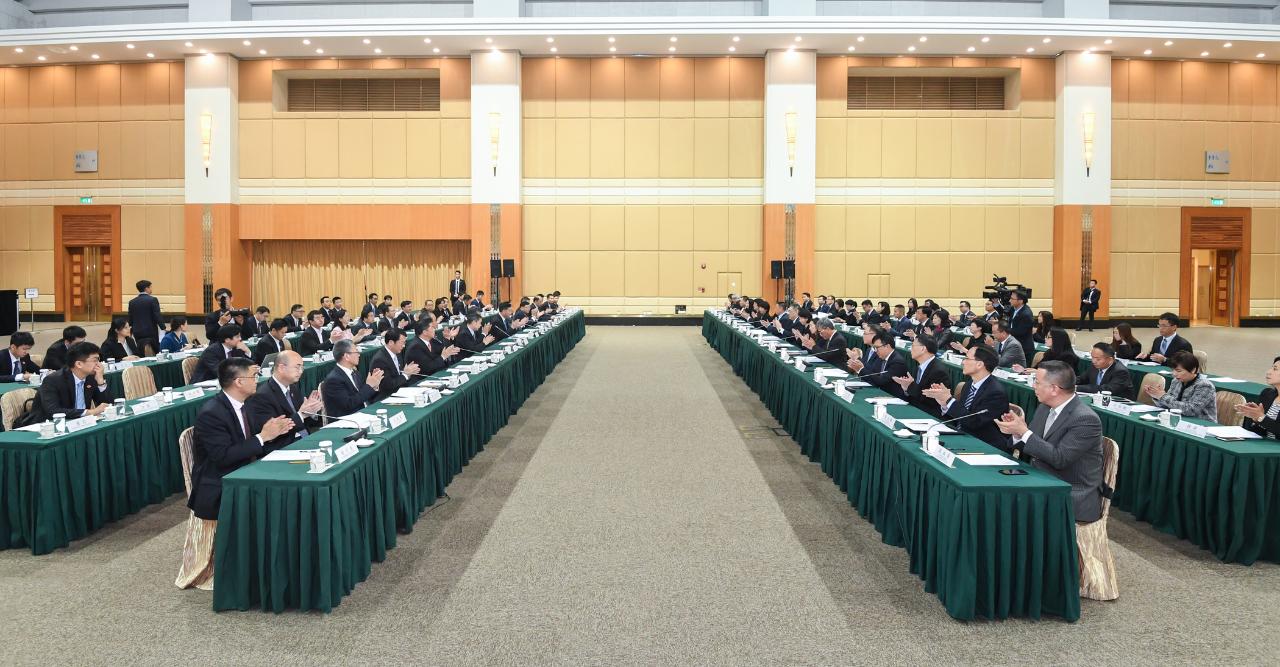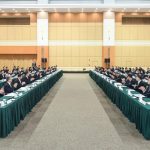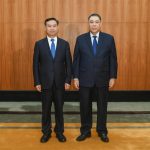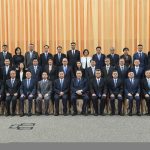 The Chief Executive, Mr Chui Sai On, meets with the Secretary of CPC Guangdong Provincial Committee, Mr Li Xi, during a Guangdong-Macao high-level meeting held in Macao.
The Chief Executive, Mr Chui Sai On, meets with the Secretary of CPC Guangdong Provincial Committee, Mr Li Xi, during a Guangdong-Macao high-level meeting held in Macao.
The latest high-level meeting of officials from Guangdong Province and the Macao Special Administrative Region (SAR) concluded with an understanding for the two places to work together in advancing the Guangdong-Hong Kong-Macao Greater Bay Area (Greater Bay Area).
The two sides would also consolidate existing cooperation in relation to furthering the diversification of Macao’s economy.
The high-level meeting was co-chaired on Wednesday (21 November) by the Chief Executive, Mr Chui Sai On, and the Secretary of the Guangdong Provincial Committee of the Chinese Communist Party (CPC), Mr Li Xi. It was held at the International Convention Centre of the Macao East Asian Games Dome.
During the meeting, Mr Chui outlined the SAR Government’s next phase of work for advancement of the Greater Bay Area, in terms of Macao’s cooperation with Guangdong. The proposed initiatives would mainly cover: collaboration with Guangdong regarding infrastructure; work toward achieving the well-being of the respective populations of the two places; and innovation in technology.
As also outlined in the SAR Government’s Policy Address for the Fiscal Year 2019, one of the directions for Macao’s adequate economic diversification was to promote steady development in the tourism and leisure sector via Government support, policy support and the support from the biggest companies in the field.
Meanwhile, the Government had stepped up support for some developing areas of the economy such as the MICE (meetings, incentives, conferences and exhibitions) sector; traditional Chinese medicine; specialised financial services; and the cultural and creative sectors.
Regarding regional collaboration, Mr Chui pointed out that the Government would participate in the development of the Hengqin and Nansha sub-zones of the Guangdong Free Trade Zone, and work with Zhongshan to develop the “Guangdong-Macao Cooperation Display Zone”
Additionally, the Government would initiate research into projects with neighbouring Jiangmen, in Guangdong Province, as a way of advancing the Greater Bay Area.
When delivering a speech at Wednesday’s meeting, Mr Li underlined that advancement of the Greater Bay Area was a prominent initiative for Guangdong. The Province hoped to see further integration of the unique advantages offered by Hong Kong and Macao, in order to make a greater contribution in the country’s overall development and to the enhancement of the people’s well-being.
The Greater Bay Area is a city cluster formed by nine major places in Guangdong Province – namely Guangzhou, Shenzhen, Zhuhai, Foshan, Huizhou, Dongguan, Zhongshan, Jiangmen and Zhaoqing – plus the two SARs, Hong Kong and Macao.
Deputy Director of the Hong Kong and Macao Affairs Office of the State Council, Mr Huang Liuquan, and Deputy Director of the Liaison Office of the Central People’s Government in the Macao SAR, Mr Zhang Rongshun, also joined Wednesday’s meeting.
Macao officials attending the meeting included: the Secretary for Economy and Finance, Mr Leong Vai Tac; the Chief-of-Office of the Chief Executive’s Office, Ms O Lam; and the Chief of Office of the Secretary for Administration and Justice, Ms Iao Man Leng.
The Guangdong delegation comprised approximately 40 people, including: the Governor of Guangdong Province, Mr Ma Xingrui; and three other members of the Standing Committee of the CPC Guangdong Provincial Committee, namely, the Secretary of the CPC Shenzhen Municipal Committee, Mr Wang Weizhong; Deputy Governor of Guangdong Province, Mr Lin Shaochun; and the Secretary of the CPC Guangzhou Municipal Committee, Mr Zhang Shuofu.




